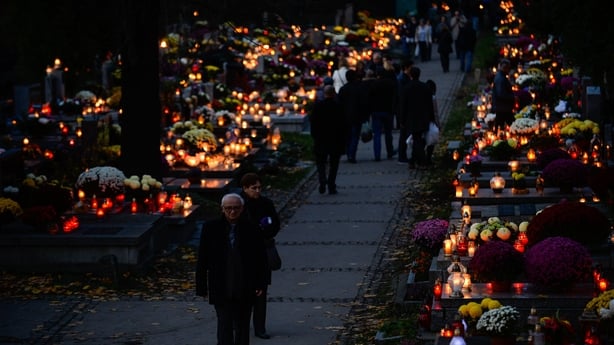Last night, on All Saints' Day, or Wszystkich Swietych in Polish, red and amber candle lights glowed in cemeteries across Poland.
For even the most secular of observers, the sight of red lights illuminating gravestones, sometimes accompanied by people singing hymns in the cold autumn air, can be a spine-tingling experience.
From early morning, roads were busy with traffic as millions of people travelled great distances across the country to visit their home towns.
It is a public holiday in Poland where 71% of the population identifies as Catholic, according to the last census in 2021. Ten years previously, that number was 87%.
People light candles in pretty decorative vases (znicze) and lay flowers at the graves of their deceased relatives, and pray to remember them.
In some of the country's biggest cemeteries, like Warsaw's Powazki Cemetery, members of the public place candles at the graves of Polish patriots, writers and even much-loved actors.
The practice of lighting candles to remember the dead at this time of year is said to date back to pagan times before Poland adopted Christianity in the late 10th century.
Over the following centuries, the ritual merged with Catholic liturgy.
But the celebration grew in importance during the 19th century when Poland was partitioned and occupied by its neighbours, Zbigniew Mikolejko, the director of religious studies at the Polish Academy of Sciences, told RTÉ News.
"During times of occupation and partition, Poles celebrated their identity in cemeteries. If you look at the details, you will see there are graves of fallen soldiers, and anonymous graves somewhere in forests, in forgotten cemeteries," said Professor Mikolejko.
This "patriotic theme", he said, both at a national and local level, was still important today.
In schools, Polish children study a longform poem called Dziady, written by the 19th century Polish poet Adam Mickiewicz, which is set during the night of 1 November before the onset of All Souls' Day on 2 November.
In the poem, villagers call out to the ghosts of deceased relatives and friends, while references to Russian occupation inhabit the verses.

I first experienced All Saints' Day in Poland on one of my first visits to the country in 2007 with my wife, who was then my girlfriend.
We drove with my now mother-in-law from their home city of Katowice two hours north to the family’s original homestead in Wielun, a town the size of Athlone.
At a windy and very busy graveyard, handshakes were exchanged with uncles, aunts and cousins.
The locals, men wearing suits and women in smart dresses, with children in tow, engaged in polite conversation and offered respectful nods of the head.
My mother-in-law lit the candles she had brought with her and prayed silently at the graves of her parents.
About a dozen young priests dressed in cassocks – they may have been seminarians – attended to the flock and followed the lead of another priest, barely in his 30s.
There was sense of reverence, rather than sadness, on display.
Afterwards, at the house of my wife’s uncle and aunt, we were served a hearty meal, and sat with other cousins and relatives.
On the drive home, cemetery after cemetery glowed bright red in the darkness.
Later that night, we met my now brother-in-law at another cemetery near Katowice.
He was lighting znicze at the grave of his best friend who had recently died in a motorbike accident. It was a sad but comforting moment for him.
Church attendance has decreased over the past decade in Poland.
A survey published last January by the country’s Institute for Catholic Church Statistics found that 28% of Polish Catholics attend mass regularly, compared with 40% in 2011.
Halloween too has become more popular in Poland in recent years, much to the dislike of the Polish clergy, who, at this time of year, criticise the practice of dressing up in costumes and trick-or-treating.
A move to a more secular society is in the air in Poland, but the collective Catholic ritual of All Saints' Day remains an important part of the country's national identity.






